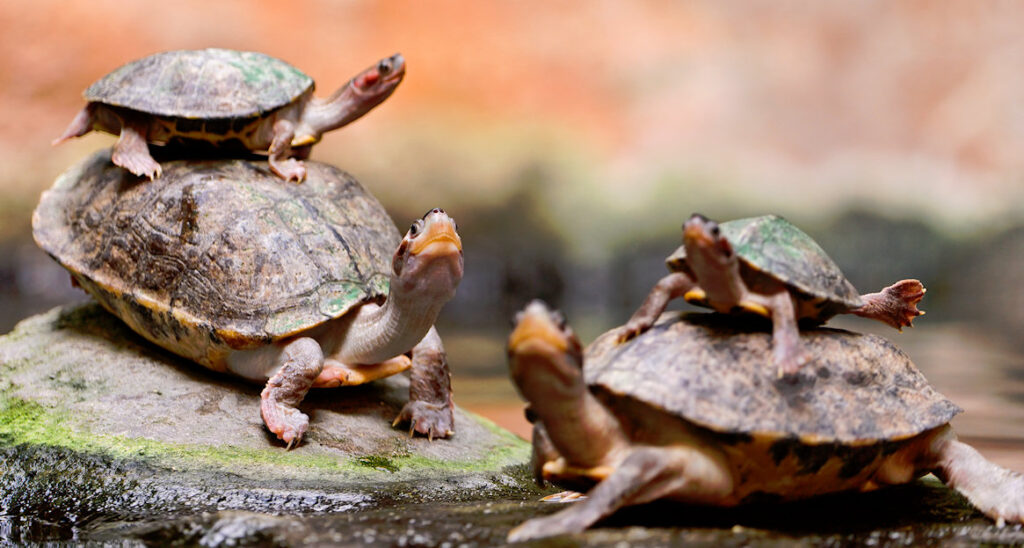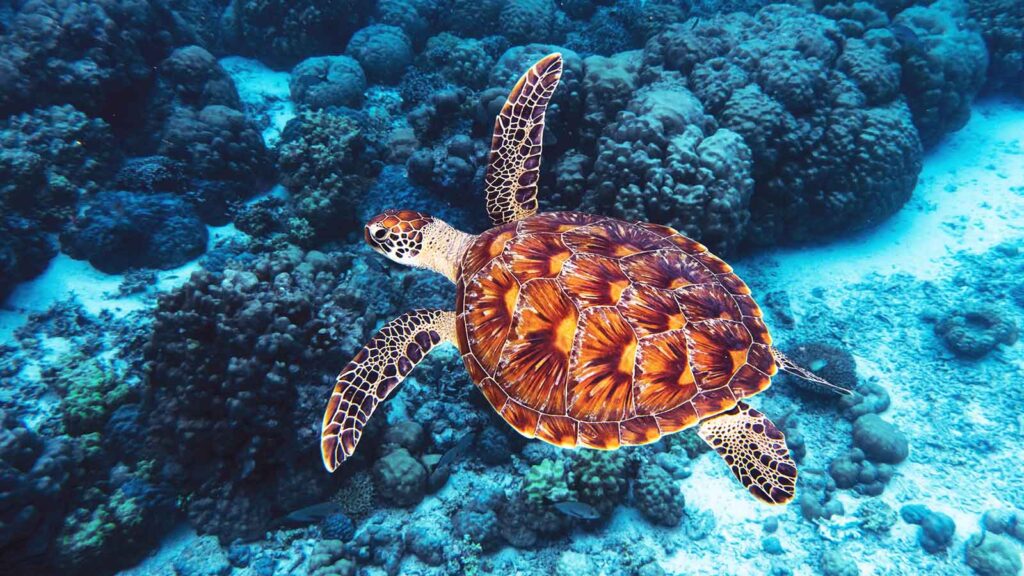Table of Contents
ToggleIntroduction

In the serene world of turtles, where slow movements and ancient wisdom converge. While these reptilian beings may not express emotions in the same exuberant manner as more animated creatures, a closer examination of their behavior and biology unveils a realm of subtle connections and intricate social dynamics. Can Turtles Feel Love? This exploration delves beyond the stereotypical stoicism attributed to turtles. This invites us to consider that these seemingly unassuming beings might harbor a capacity for emotions, including a primitive form of what humans recognize as love.
In this journey through the enigmatic world of turtle emotions, we will navigate the complexities of their behavior, scrutinize their brain structures, and draw insights from their natural habitats and captive environments. By peering into the lives of these ancient beings, we embark on a quest to unravel the mysteries of turtle emotions and discern. Whether beneath their protective shells, they beat the heart of a creature that can feel and express love.
Understanding Turtle Behavior
To delve into the question of turtle emotions, it’s essential to understand their behavior. Turtles are reptiles, so their behavior differs significantly from mammals, often considered more emotionally expressive. While mammals like dogs and cats exhibit overt signs of affection, turtles display emotions in subtler ways.
One aspect of turtle behavior that suggests a capacity for emotion is their social interactions. Some turtle species bond with their peers by basking together or swimming nearby. These social behaviors indicate connection and comfort among individuals, hinting at a social structure involving more than survival instincts.
The Role of Brain Structure
Examining their brain structure is crucial to exploring the possibility of turtles experiencing emotions like love. While the turtle brain is not as complex as that of mammals, it does show some intriguing features. The amygdala, a region associated with processing emotions, is present in turtles, albeit in a simplified form compared to mammals. This suggests that turtles may have the capacity to experience basic emotions.
Whether turtles feel love becomes more intricate when considering that their brain structure is adapted to their needs and lifestyle. Turtles have evolved to navigate land and water; their brains reflect this dual existence. Understanding the nuances of turtle neurobiology is essential in deciphering the extent of their emotional capabilities.
Observing Turtles In The Wild

Researchers often turn to observations in the wild to gain insight into the emotional lives of turtles. Studying turtles in their natural habitat provides a more accurate representation of their behaviors, free from the constraints of captivity. Researchers have documented turtles forming strong bonds with mates and displaying behaviors beyond survival instincts.
One striking example is the courtship rituals of some turtle species. Male turtles often display elaborate displays to attract females, showcasing behaviors beyond mere mating instincts. These displays can include intricate movements, vocalizations, and even tactile interactions, suggesting a level of social and emotional engagement.
Turtle Relationships In Captivity
Observations of turtles in captivity also contribute to our understanding of their emotional lives. While captivity can alter behavior to some extent, long-term studies reveal interesting patterns. Turtles kept in pairs or groups sometimes display behaviors that indicate social bonds, such as staying close to one another. Engaging in synchronized activities or even showing signs of distress when separated.
However, it’s crucial to approach these observations with caution. The stress of captivity, limited space, and altered environmental conditions can influence turtle behavior, potentially leading to behaviors that may not accurately represent their natural tendencies. Nevertheless, the patterns observed in captivity can offer valuable insights into the potential for emotional experiences in turtles.
Tactile And Visual Communication
Communication is a fundamental aspect of social behavior, and turtles have evolved various ways to interact with one another. While their methods may differ from those of more expressive animals, turtles communicate through tactile and visual cues.
Tactile communication, such as gentle nudges or touches, is common among turtles. This interaction is particularly evident during courtship, mating, or even within social groups. Visual signals, including body movements and postures, are crucial in turtle communication. These non-verbal cues suggest understanding and responsiveness that go beyond mere instinctual responses.
Parental Care In Turtles
Examining parental care in turtles provides another angle to explore their emotional capacity. While not all turtle species exhibit extensive parental care, some are known for their involvement in rearing offspring. After laying eggs, female turtles may remain near to protect the nest or even assist the hatchlings in reaching the water.
The act of guarding nests and aiding offspring suggests a level of attachment and concern for the well-being of their young. While this may not be a direct indicator of love as humans understand it, it points to a sense of responsibility and connection beyond basic reproductive instincts.
Scientific Studies On Turtle Emotions
Scientific research on turtle emotions is relatively understudied, primarily due to the challenges of interpreting emotions in non-human species. However, some studies have attempted to shed light on this intriguing question.
One study published in the journal “Animal Behaviour” explored the social behavior of painted turtles (Chrysemys picta). The researchers observed that turtles preferred specific individuals within their social group, indicating a level of social bonding. While the study did not explicitly delve into the emotional experiences of turtles, it laid the groundwork for understanding the complexity of their social interactions.
Another study published in “Zoology,” examined the brain structure of turtles and found that the amygdala, a region associated with emotional processing, displayed notable variations among different species. This suggests that while turtles may not experience emotions like mammals, their brains have a degree of emotional processing.
Anthropomorphism And Interpretation
A significant challenge in studying animal emotions, including those of turtles, is the risk of anthropomorphism—attributing human emotions and experiences to non-human animals. It’s essential to approach the question of turtle emotions with a balanced perspective, recognizing that their experiences may differ significantly from human emotions.
While turtles may not feel love in the human sense, their behaviors and interactions suggest a capacity for social bonding, attachment, and perhaps a more primitive form of emotional experience. Applying a nuanced understanding that considers the unique evolutionary and ecological context of turtles is crucial in avoiding the pitfalls of anthropomorphism.
Conclusion
While the emotional lives of turtles may not mirror human experiences, there is mounting evidence that they engage in social behaviors, form bonds, and display a level of attachment beyond basic survival instincts.
Understanding turtle emotions requires a multidimensional approach considering their behavior, brain structure, and social interactions. Observations in the wild and captivity, coupled with scientific studies, contribute to our evolving understanding of the emotional lives of these slow-moving creatures.
In conclusion, while we may never fully comprehend the depth of turtle emotions, the evidence suggests that there is more to their lives than meets the eye. Turtles, with their ancient lineage and unique adaptations, remind us that the emotional spectrum in the animal kingdom is vast and varied, offering endless opportunities for exploration and discovery.







